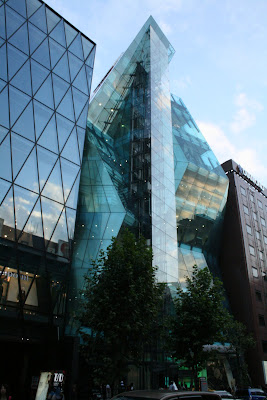If there was space in the sardine can of a subway car, I would have photographed the close quarters. But my nose tickled from rubbing against the girl’s hair in front of me. Raising my arm from my hip to eye level would have meant practically groping people. After more than a month and a half of living in Tokyo, I had my first claustrophobic subway experience as peopled crammed to catch the last train to Shinbashi at midnight. It was so tight the people near the doors almost fell out at each stop. A few stops away from my destination, everybody turned to face me, and I realized the exit doors would open on my side. I grabbed a handrail to steady myself as the rush of people boarding and exiting the subway threatened to pull me out of the car. I smiled because it reminded me I was still in Tokyo.
It seems like I am still a fresh arrival to Nippon, yet I have already finished midterms. Every day I walk the same way to classes, no longer craning my neck in awe at Azabu-Juban’s spiral stairwells and sleek architecture but with my headphones plugged in and my mind wandering elsewhere like everybody else. I buy the same discounted packages of Korean ramen, an economic staple of my daily diet, from the same convenience store near my hotel once a week. Finding the order to build routine amid the madness of Tokyo shows growth, but it also risks curtailing the spontaneity that has fueled some of my most memorable adventures.
So, continuing to push myself outside comfortable territory in my pursuit of curiosity has become paramount. The packed subway car was yet another means to that end. My itinerary included meeting a friend at the Crow Forest bar in Shinbashi, a late night hub for Tokyo’s business class, wait for the subways to re-open around dawn and then visit the world’s largest fish market in Tsukiji to see its tuna auction.
When I got to Crow’s Forest after midnight, many business men and women had already rolled up their sleeves and spastically swung their limbs on the dance floor, as if in acknowledgement of a gospel of salvation they heard in the sounds of Abba and disco-era Kiss.
One patron whispered to me of a silent practice of unpaid overtime several nights a week at some jobs. Beyond the office, employees are encouraged and even expected to imbibe with their superiors regardless of the time and the tally if they hope to advance in a company. I realized the world of 9-to-5 jobs represents much more than employment. Instead, it’s a lifestyle.
When dusk had brightened the twilight sky, I boarded a subway toward Tsukiji, which rests among industrial buildings and skyscrapers on the Sumida river. More than 900 vendors sell everything from the treasures of the ocean to fruits, vegetables and cutlery, but there is no room for the weary. The main tuna auction ends after 6 a.m., and many of the wholesale fish vendors and aromatic soup shops close for the day soon after.
Alleyways teamed with men in smocks competing to carry and unload ice boxes of the day’s catch in the same space as scooter traffic and other shoppers like myself. My camera and outward appearance magnified how out of place I felt, but I kept moving with the flow of people, stopping for a few minutes to shoot an image, circling the market place and re-visiting the same spots for pictures until I was satisfied.
Every inch of the market had more crates packed with slimy textures and briny odors on ice. Vendors conversed while slicing meaty slabs of tuna into filets with 30-inch blades. Needle-shelled crabs and lobsters wrestled in tanks.
It was hardly daylight, and I was exhausted and starving. I bought a bento box of mackerel sashimi so fresh its scales still glistened and I savored its rich, salty coarseness.
Perhaps letting myself feel too much at home in Tokyo would be permitting my heart to be broken in December when I must return to the states, so I resist it. Tsukiji should keep me on guard for some time because it will take many visits for me to see all of the gargantuan fish market’s pearls.















































